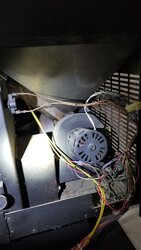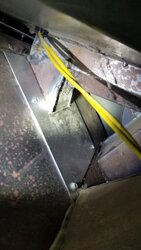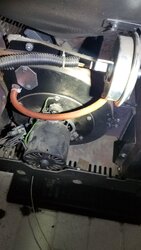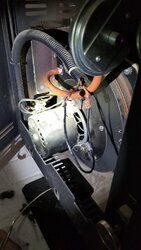I have a Whitfield Pellet Stove probably about 5 years old. I just deep cleaned the whole thing so it is really cleaning even the exhaust vent. When I power it up it automatically drops the pellets needed to stsrt up and light . The flame is solid right where it needs to be but then it decides to drop another handful of pellets as of it is starting up again. This makes the flame huge and burn really hot. After a few minutes all the pellets are red embers with no flame. The auger kicks in (a little late) but only makes 3 rotations then stops leaving the stove to burn itself out. Without pressing anything after about 5 min the process starts over again. I am no expert but maybe it is getting too hot with that 2nd group of plets and exceeding the temp of 160 F which might turn off the auger motor for safety?
Trouble with Pellet Stove not staying lit.
- Thread starter Domember
- Start date
-
Active since 1995, Hearth.com is THE place on the internet for free information and advice about wood stoves, pellet stoves and other energy saving equipment.
We strive to provide opinions, articles, discussions and history related to Hearth Products and in a more general sense, energy issues.
We promote the EFFICIENT, RESPONSIBLE, CLEAN and SAFE use of all fuels, whether renewable or fossil.
You are using an out of date browser. It may not display this or other websites correctly.
You should upgrade or use an alternative browser.
You should upgrade or use an alternative browser.
JRemington
Minister of Fire
Where would i find this? Im sorry im rather new to pellet stoves.Check the vacuum switch. When it opens the auger won’t turn.
I foind the Vacuum Switch if i was to unplug the 2 wires and bypass the vacuum by connecting them that should tell me if the vacuum has gone bad right?Check the vacuum switch. When it opens the auger won’t turn.
Ssyko
Minister of Fire
I found a gap right where the light is i wonder if thats what is breaking the vacuum pressure.
Attachments
JRemington
Minister of Fire
Ehhhhh?Here is the vacuum before i bypass it
Attachments
It does the same thing... drips pellets for about 30 sec then atarts to burn out does it for another 30 sec then fire goes out. Also note that the function on my control panel for low medium high heat doesnt seem to make a difference nor does the fan control it is like it is locked on one setting. I did remove all the wires from the control panel to ensure it had a solid connection.
Ssyko
Minister of Fire
Yep sounds like a vacuum issue which could be a weak combustion blower, restriction in the vent or the path through the stove. Or a bad vac switch
JRemington
Minister of Fire
Take the tube off and be sure there are no holes. Take a piece of wire and clean out the port going into the firebox. If that is plugged the vacuum switch won’t close.
So i took the tube off it was clear. Looking into the stove when it was running i could feel air come out rather fast from a gap on the back side of the... i dont know what to call it where all the fans are and wiring. It looks almost like there use to be that heat resistant fabric there but now its gone and it is leaking alot of the hot air from the stove in and keeping it inside it rather then forcing majority of it through the chimney and front blower. I have this black tar like substance that is made for sealing vents and things that get hot. Do you think if i seal it with it that would cause any major issues? I let the stove run a bit with it bypassing the vacuum and i believe it may have shut down to overheating since most of the heat was inside the stove housing. Also thank you so much for all your help have made great progress so far.
Stovensen
Minister of Fire
It does the same thing...
On most Whits the pneumatic safety switch is a pressure activated switch: It monitors the exhaust for a sudden and dangerous pressure rise caused by restrictions in the flue ( a snow drift, excessive fly ash, a birds nest, leaves, etc ). Such a restriction could make the stove pump lethal carbon monoxide into the room, if not for the pressure activated safety switch.
Therefore the pressure switch is normally closed, so bypassing it will have no effect in your test situation, which is also what you have experienced.
Also note that the function on my control panel for low medium high heat doesnt seem to make a difference nor does the fan control it is like it is locked on one setting. I did remove all the wires from the control panel to ensure it had a solid connection.
Have you checked the connections to the thermostat, or, if you have no thermostat, have you checked if the thermostat jumper has lost its connections? When you cannot change the settings on a Whitfield - always on low like on yours - it is typically a missing thermostat jumper, or it has lost its connection to the control board. Easy to check and fix.
Good luck and take care. Keep us posted
Last edited:
So after jumping the vacuum switch once the stove ran like normal (dropping pellets and staying lit) the functions to the control pannel returned i was able to adjust the pellet drop rate and blower via control pannel. In the morning i am going to either use stove tape or heat resistant mortar to seal those air leaks i found dumping excessive heat in the main space under the hopper. The air seems to be leaking out from the back side of the chute that guides the pellets into the pot. So i will seal that up and reinsert the connections to the vacuum switch to see if the system fails like it did before the jump. If it fails then i will replace the switch. I have also cleaned the pipe leading to the outside really well there are no obstructions in it nor does any smoke escape into the house just little gaps of heat.On most Whits the pneumatic safety switch is a pressure activated switch: It monitors the exhaust for a sudden and dangerous pressure rise caused by restrictions in the flue ( a snow drift, excessive fly ash, a birds nest, leaves, etc ). Such a restriction could make the stove pump lethal carbon monoxide into the room, if not for the pressure activated safety switch.
Therefore the pressure switch is normally closed, so bypassing it will have no effect in your test situation, which is also what you have experienced.
Have you checked the connections to the thermostat, or, if you have no thermostat, have you checked if the thermostat jumper has lost its connections? When you cannot change the settings on a Whitfield - always on low like on yours - it is typically a missing thermostat jumper, or it has lost its connection to the control board. Easy to check and fix.
Good luck and take care. Keep us posted
Stovensen
Minister of Fire
So after jumping the vacuum switch once the stove ran like normal (dropping pellets and staying lit) the functions to the control pannel returned i was able to adjust the pellet drop rate and blower via control pannel.
When fiddling with the jumper wire you may have bumped the thermostat wires, causing them the conduct temporarily? Periodic failures are among the worst technical nightmares. I would inspect the thermostat wires and their connections very thoroughly.
Note: From the thermostat terminals on the back of your stove there is a wire leading to the control panel. This could be the culprit. To rule out any loose connections here, making a thermostat jumper in this way, may be most secure:
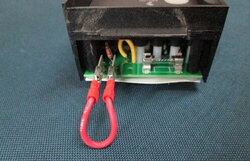
Your control board may be from a newer Whitfield model and different from that on the pic.
BTW, you haven't informed us the exact model, but since there is no low limit switch in the exhaust next to the pressure hose, it has to be a model with the photo eye flame watch system. We clearly see the metal plate covering the hole on the blower housing, where the low limit switch is located on the older Whits.
If it fails then i will replace the switch
It is very easy to check the pressure switch for correct functionality: Unplug stove, and connect an ohmmeter to the terminals on the microswitch mounted on the housing containing the rubber diaphragm. The ohmmeter should read zero Ohms=Normally Closed. Now you disconnect the pressure hose from the exhaust blower housing. Very gently blow ( not suck ) in this hose, until the rubber diaphragm makes the contacts in the micro switch open with an audible click, and the ohmmeter should now read infinite Ohms. Also, you should feel tight resistance when blowing, meaning that the rubber diaphragm is tight and intact.
Note: If the micro switch has three terminals on it, it means that the pneumatic sensor can be used to monitor both vacuum and pressure, but I repeat: In your Whitfield stove the pneumatic safety switch is used to sensor a pressure rise.
We can also clearly see it from the location of the silicone hose: It is located on the output side of the combustion blower, where a vacuum cannot be generated by the blower.
Last edited:
I checked the vacuum switch itnis good. Thermostats look good as well. But while testing these i did notice it looks like the ignitor may be staying on in thebstarting process. It burns through the bowl of pellets pretty quick. I think thats why i dont have the ability to adjust the pellet rate and the blower because it js stuck in start up? It ends up burning through 3 start up processes worth of pellets. No faults or errors it just starts when the flame turns to embers.
Stovensen
Minister of Fire
Oh, so it was the dreaded photo eye that was causing the issue, like we've seen so many times before on this forum. Congrats with your finding. Now enjoy the heat.
But to prevent this issue from happening in the future you could easily retro fit your stove with the low limit POF switch used in the older Whitfields.
Forum member Don2222 made a very thorough thread on this with pics and all, and it works:
https://www.hearth.com/talk/threads...ery-anyone-try-this-see-pics-it-works.132882/
But to prevent this issue from happening in the future you could easily retro fit your stove with the low limit POF switch used in the older Whitfields.
Forum member Don2222 made a very thorough thread on this with pics and all, and it works:
https://www.hearth.com/talk/threads...ery-anyone-try-this-see-pics-it-works.132882/
Similar threads
- Replies
- 18
- Views
- 591
- Replies
- 6
- Views
- 1K
- Replies
- 1
- Views
- 198
- Replies
- 2
- Views
- 498


